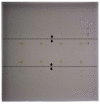Optimization of Adsorbent Layer Type and Developing Solvent in Coccidiostats Sample Preparation with Procedure of Solvent Front Position Extraction
- PMID: 33353181
- PMCID: PMC7766046
- DOI: 10.3390/molecules25246011
Optimization of Adsorbent Layer Type and Developing Solvent in Coccidiostats Sample Preparation with Procedure of Solvent Front Position Extraction
Abstract
Coccidiostats are drugs used against coccidiosis, a common disease among breeding animals. Their widespread application leads to the appearance of their residues in food, which is potentially harmful for human health and life. The European Union has established limits of concentrations of these drugs in premixtures and food. Nowadays, there are many methods for monitoring coccidiostats' presence in market products, but their frequent weakness is sample preparation. Solvent Front Position Extraction is a planar chromatography-based sample preparation method that allows for effective assay of samples with coccidiostats when coupled with LC-MS/MS. The purpose of this research was to find common conditions for the effective isolation of eight coccidiostats from biological sample components with both lower and higher retention than the substances of interest. The acquired results were used for effective isolation of monensin and salinomycin from the premixture samples and allowed for their quantitative determination. The application of a semi-automatic device for the development of chromatograms positively impacted the results, confirming the effectiveness of the method for determining coccidiostats in biological samples.
Keywords: Solvent Front Position Extraction; coccidiostats; liquid chromatography-tandem mass spectrometry; sample preparation; thin-layer chromatography.
Conflict of interest statement
The authors declare no conflict of interest. The funders had no role in the design of the study; in the collection, analyses, or interpretation of data; in the writing of the manuscript, or in the decision to publish the results.
Figures








Similar articles
-
Solvent Front Position Extraction and some conventional sample preparation techniques for the determination of coccidiostats in poultry feed by LC-MS/MS.Sci Rep. 2022 Mar 8;12(1):3786. doi: 10.1038/s41598-022-07587-5. Sci Rep. 2022. PMID: 35260618 Free PMC article.
-
Determination of Eight Coccidiostats in Eggs by Liquid-Liquid Extraction-Solid-Phase Extraction and Liquid Chromatography-Tandem Mass Spectrometry.Molecules. 2020 Feb 22;25(4):987. doi: 10.3390/molecules25040987. Molecules. 2020. PMID: 32098439 Free PMC article.
-
Solvent Front Position Extraction with Semi-Automatic Device as a Powerful Sample Preparation Procedure Prior to Quantitative Instrumental Analysis.Molecules. 2019 Apr 6;24(7):1358. doi: 10.3390/molecules24071358. Molecules. 2019. PMID: 30959894 Free PMC article.
-
Screening methods and recent developments in the detection of anticoccidials.Anal Bioanal Chem. 2013 Sep;405(24):7733-51. doi: 10.1007/s00216-013-7035-6. Epub 2013 May 29. Anal Bioanal Chem. 2013. PMID: 23712646 Review.
-
Veterinary drugs residues: a review of the latest analytical research on sample preparation and LC-MS based methods.Food Addit Contam Part A Chem Anal Control Expo Risk Assess. 2017 May;34(5):766-784. doi: 10.1080/19440049.2017.1298846. Epub 2017 Apr 12. Food Addit Contam Part A Chem Anal Control Expo Risk Assess. 2017. PMID: 28278127 Review.
Cited by
-
Solvent Front Position Extraction and some conventional sample preparation techniques for the determination of coccidiostats in poultry feed by LC-MS/MS.Sci Rep. 2022 Mar 8;12(1):3786. doi: 10.1038/s41598-022-07587-5. Sci Rep. 2022. PMID: 35260618 Free PMC article.
References
-
- . Regulation (EC) No. 1831/2003 of the European Parliament and of the Council of 22 September 2003 on additives for use in animal nutrition. Off. J. Eur. Union Bruss. 2003;L268:29–43.
MeSH terms
Substances
LinkOut - more resources
Full Text Sources

